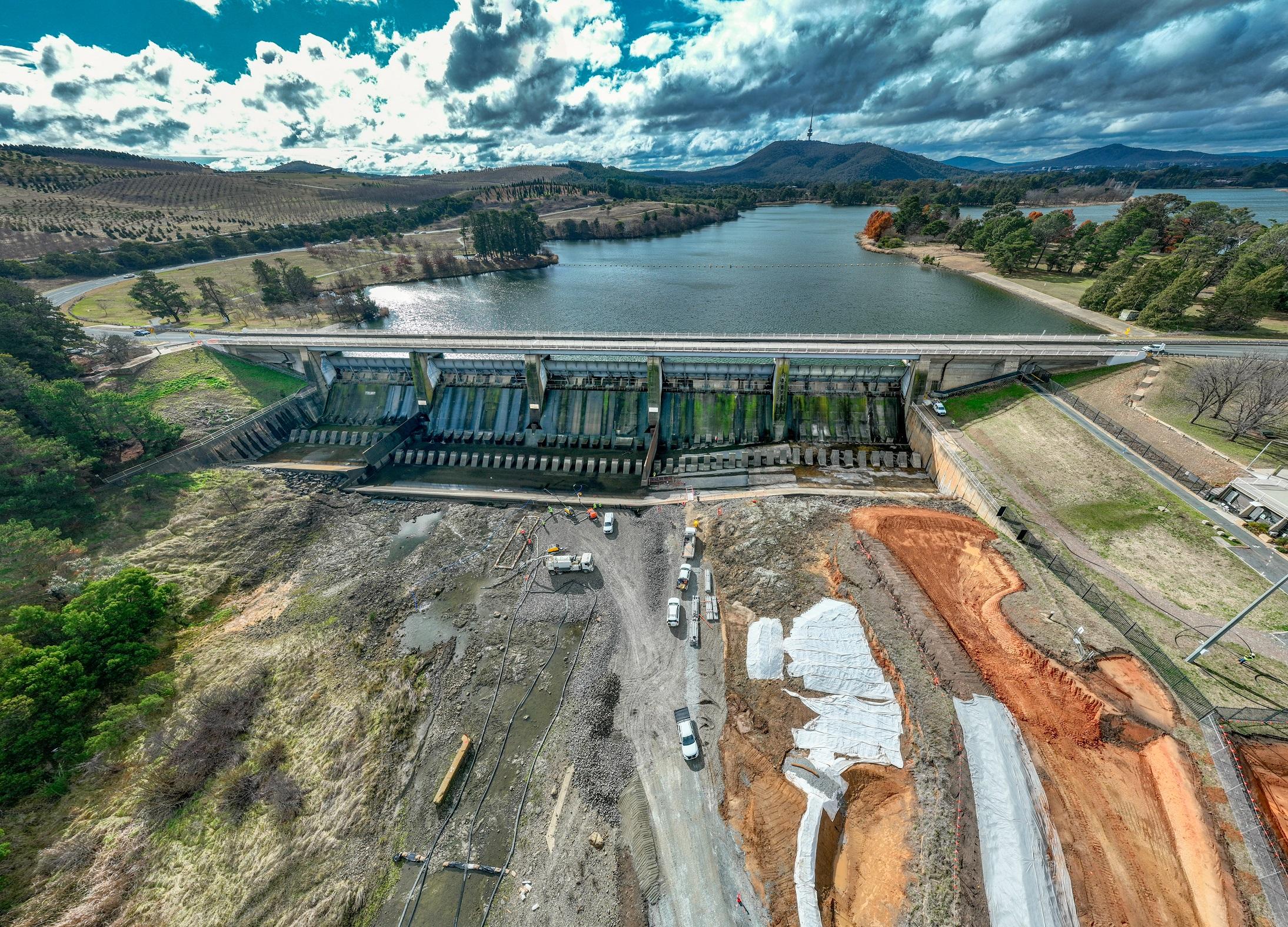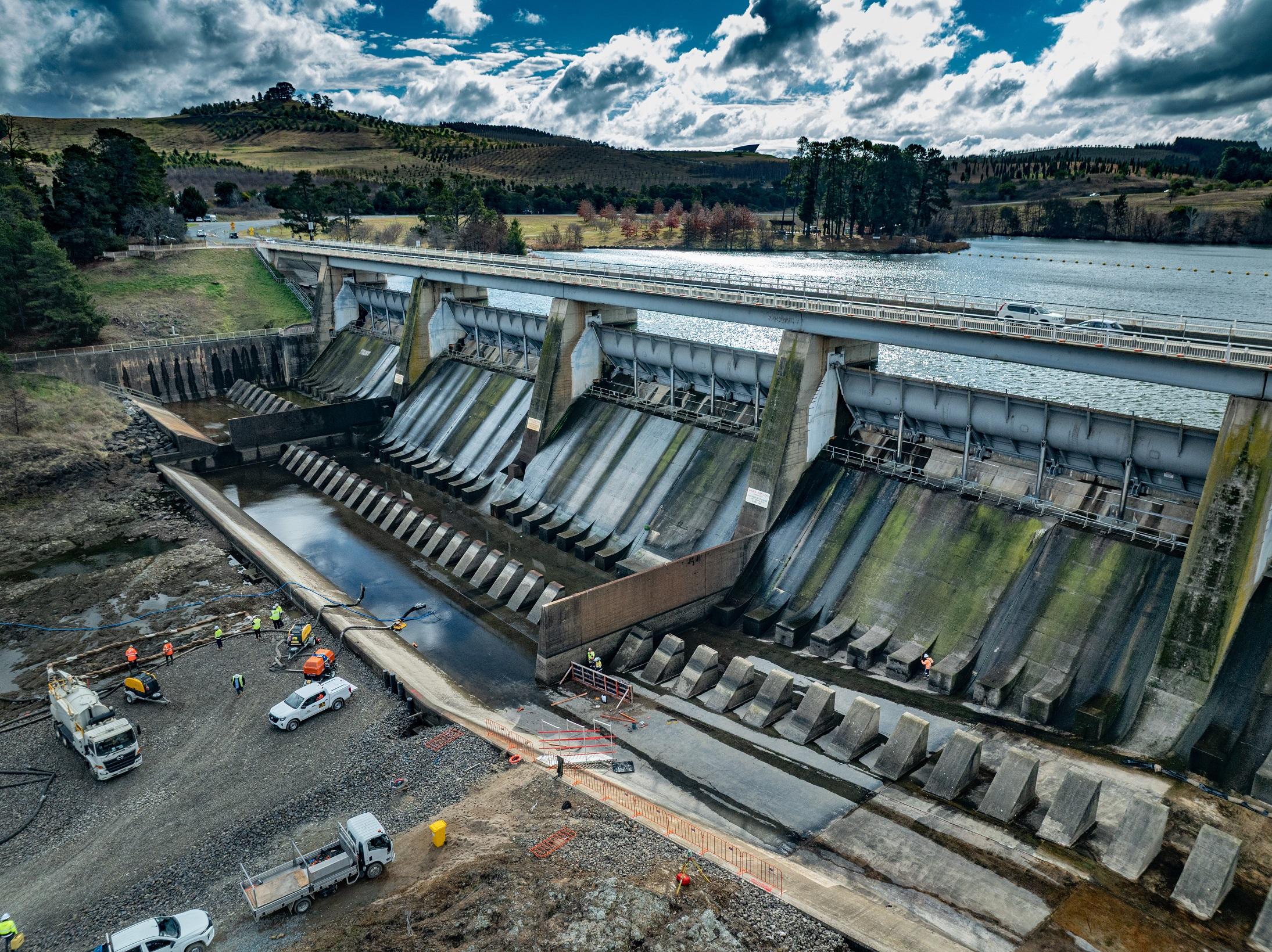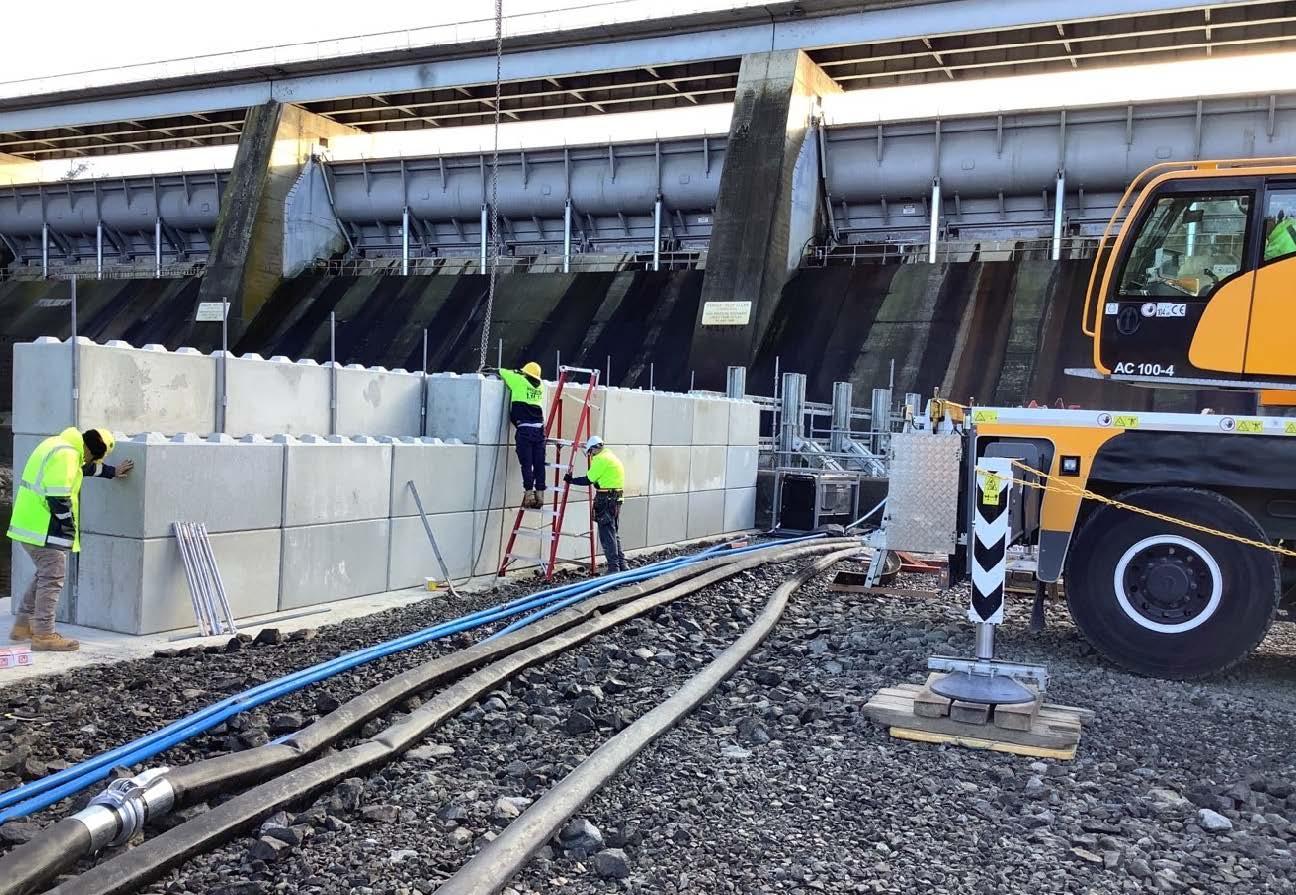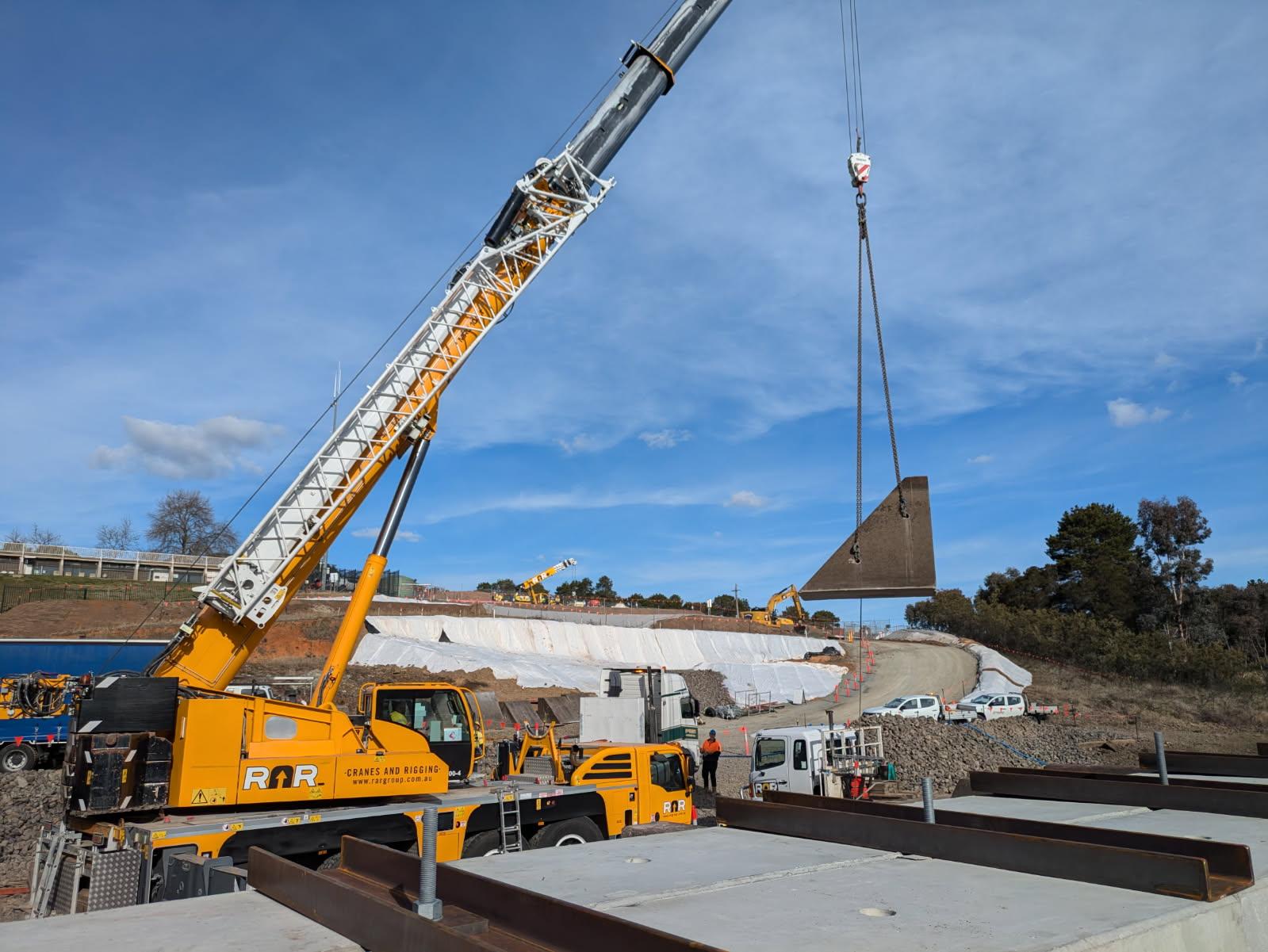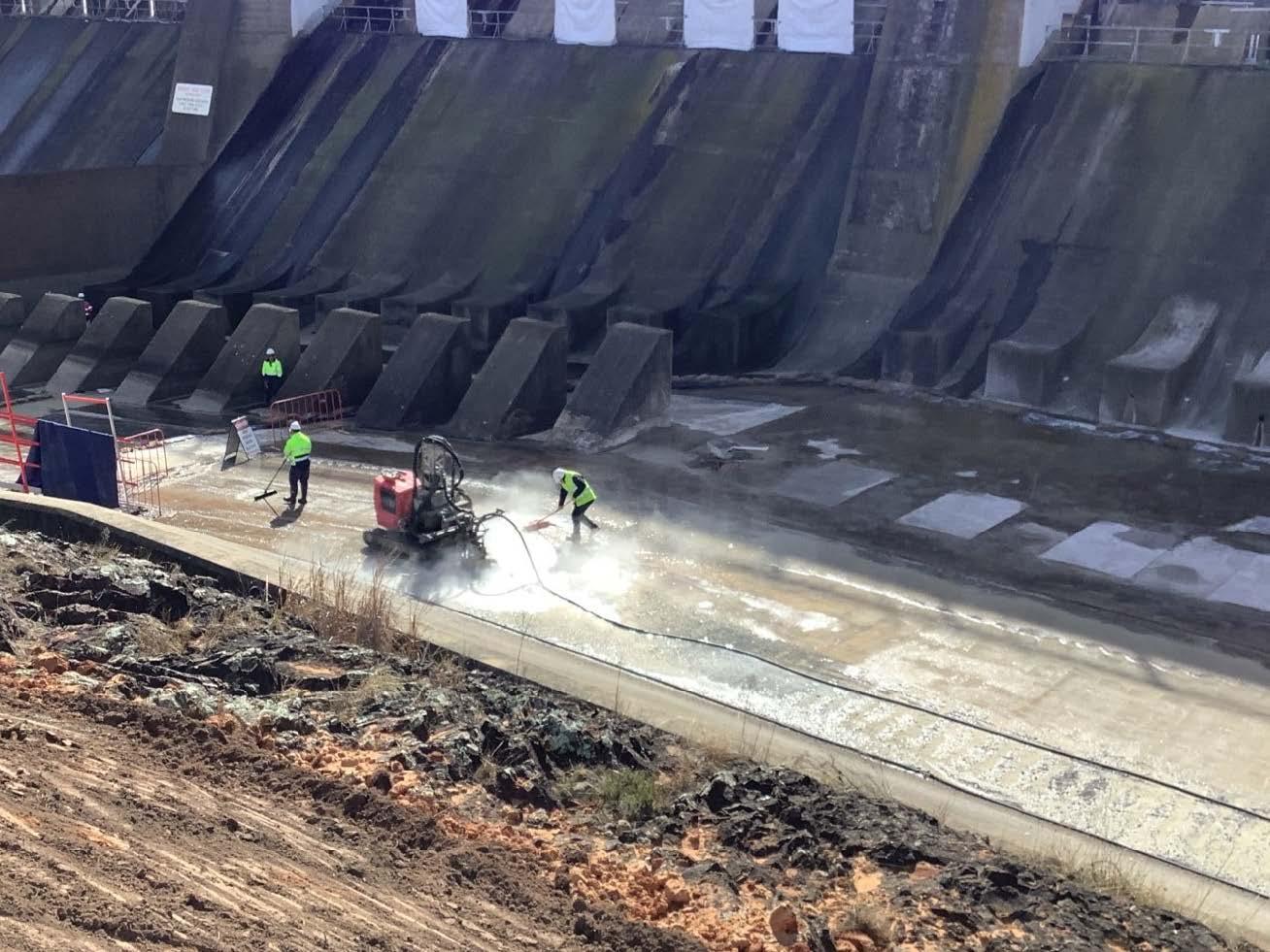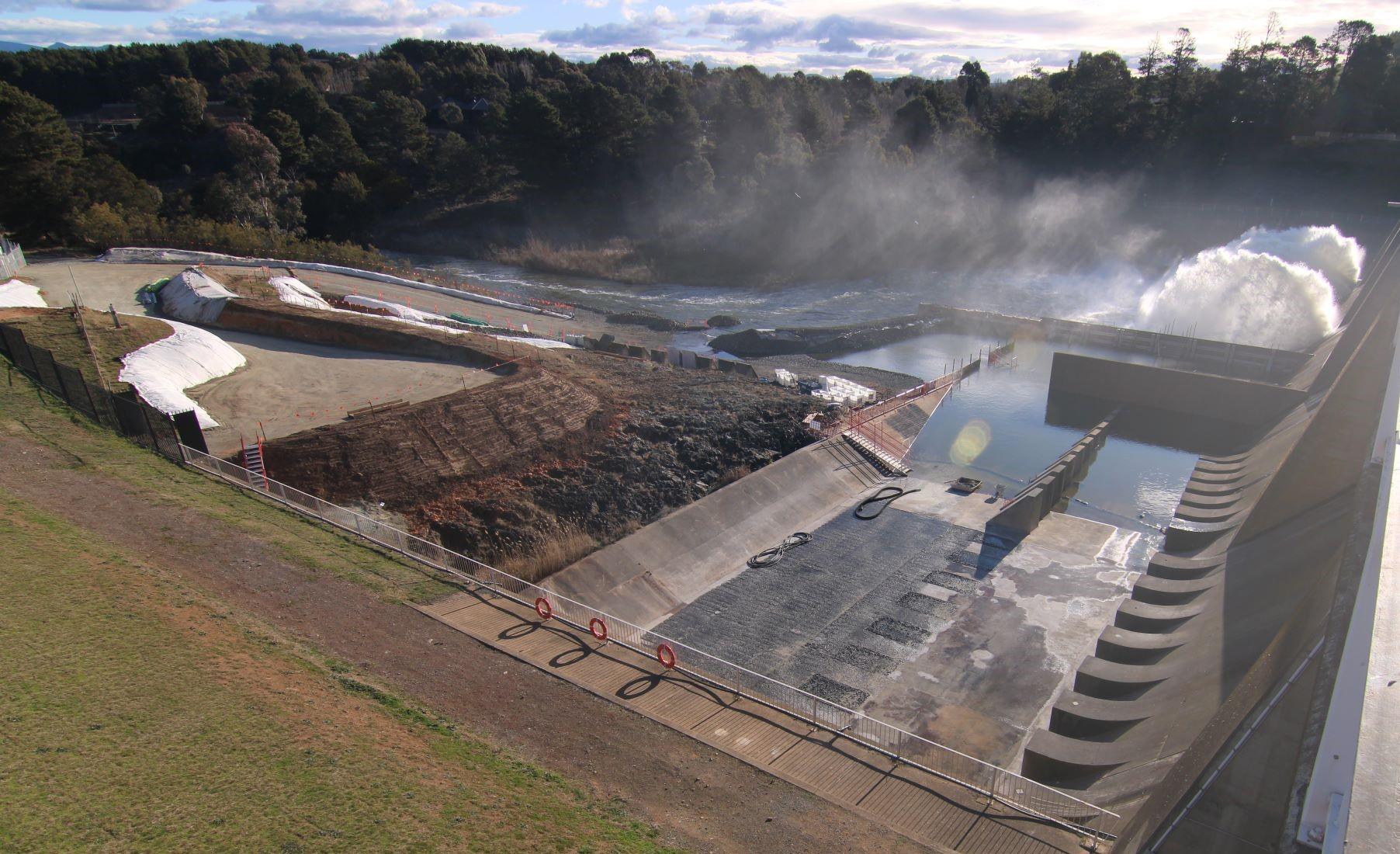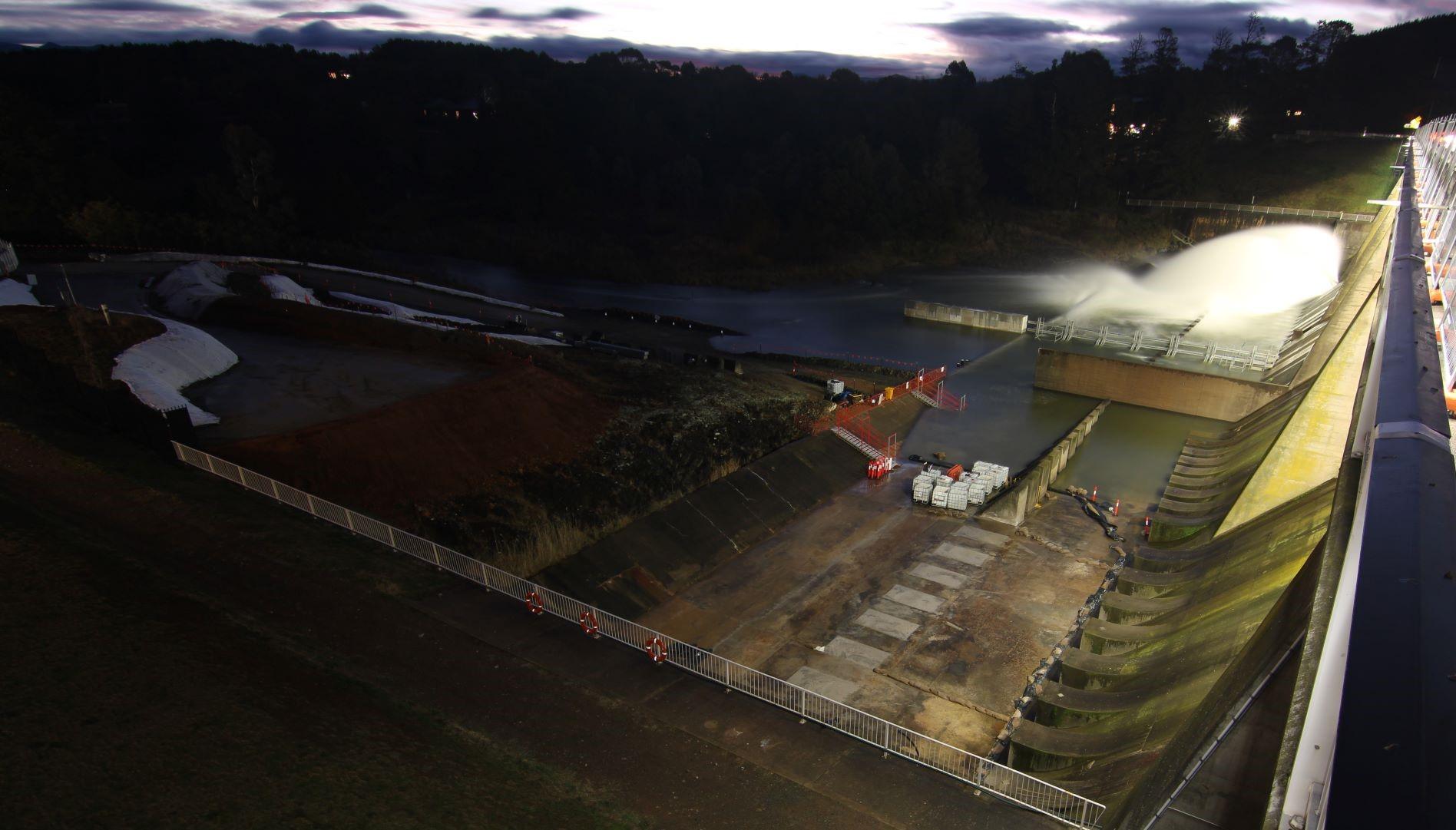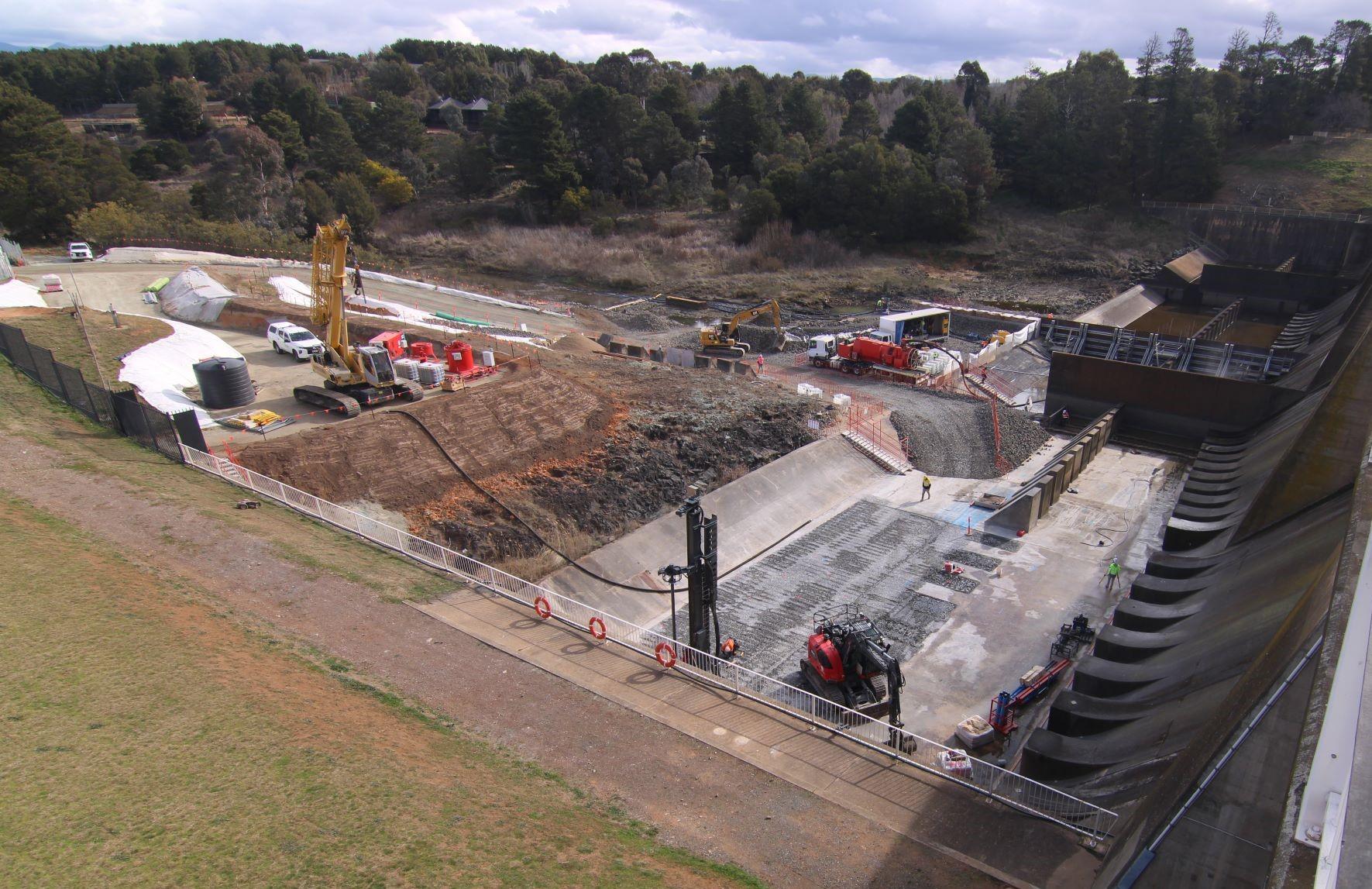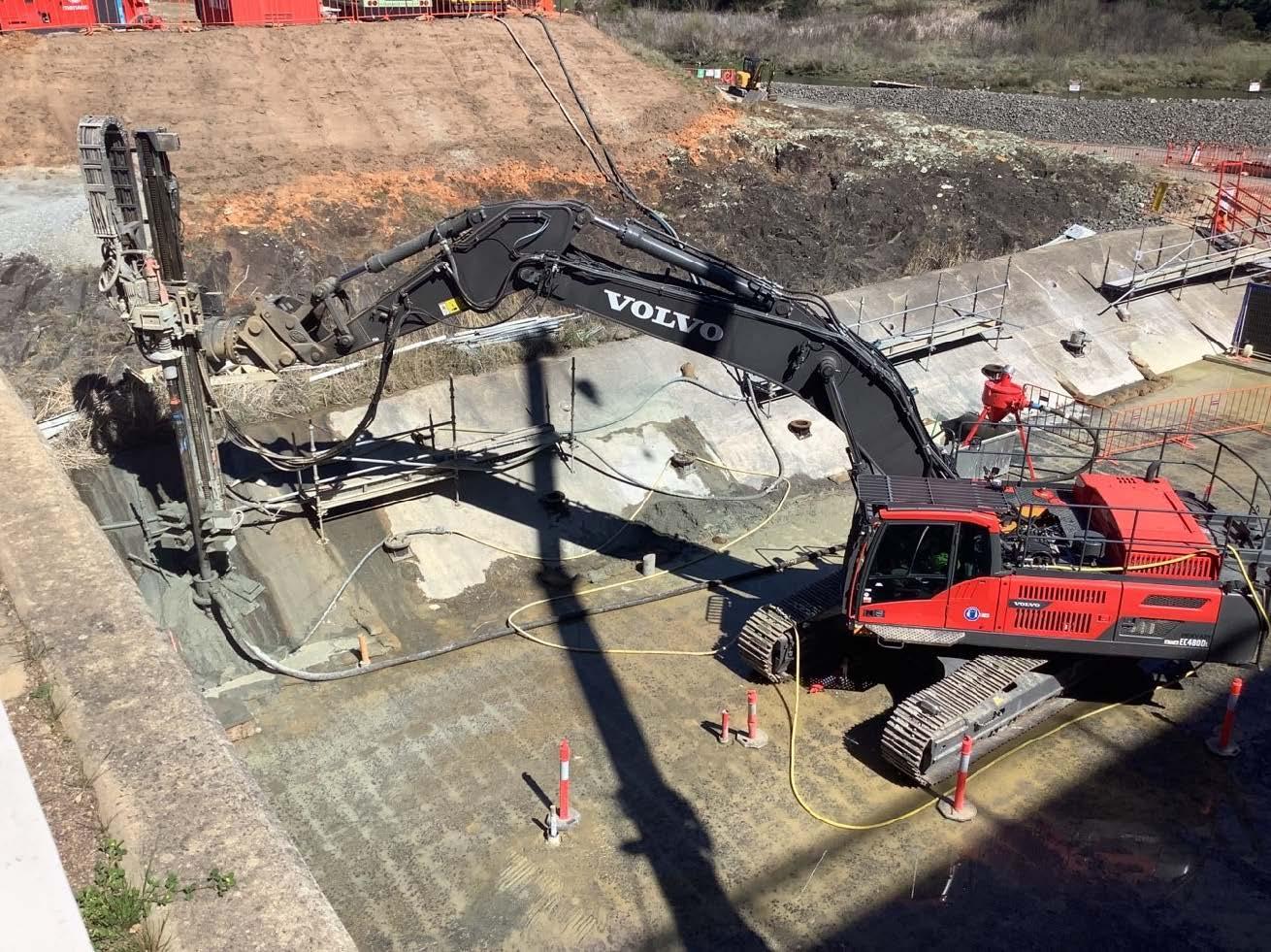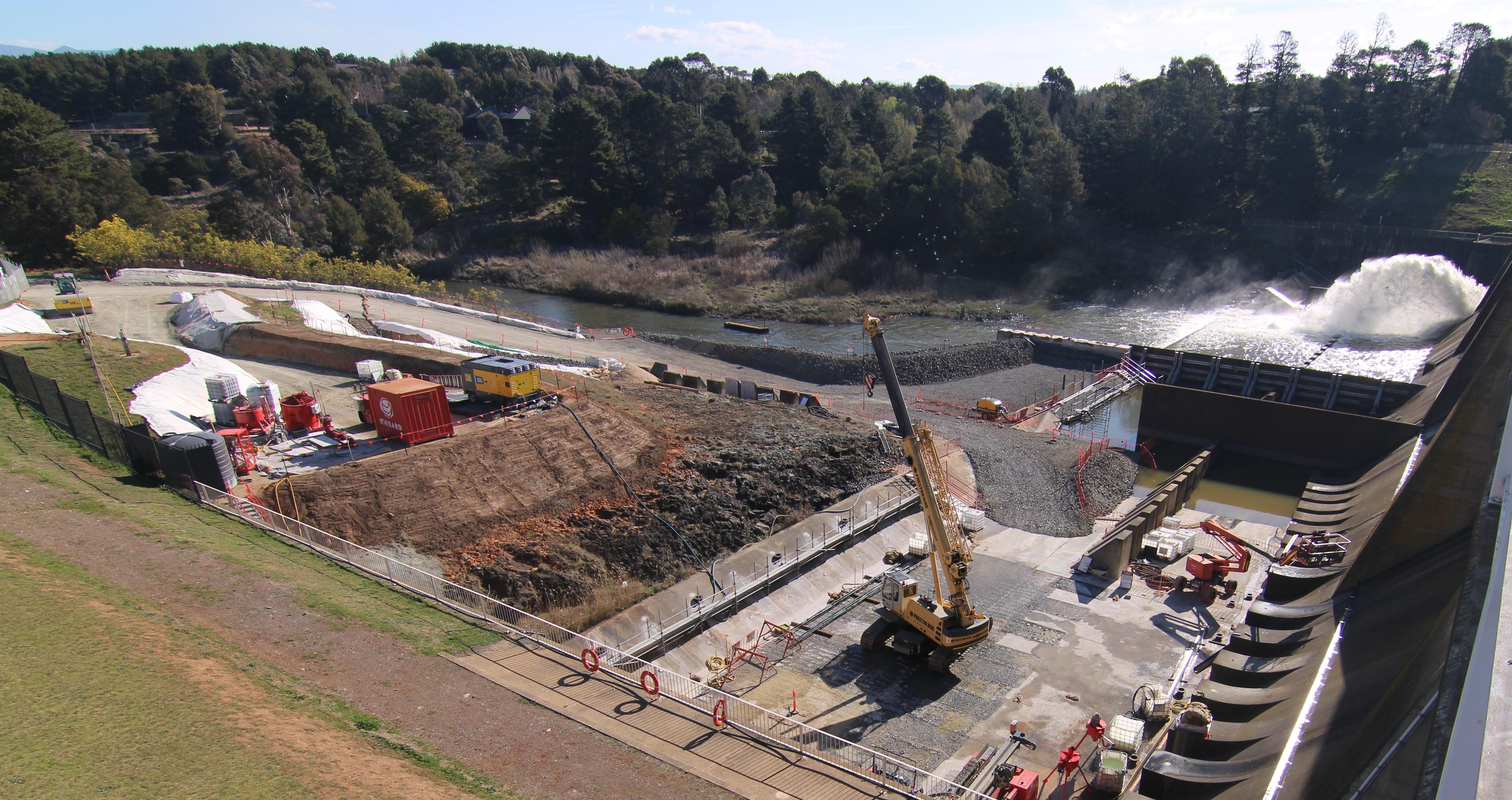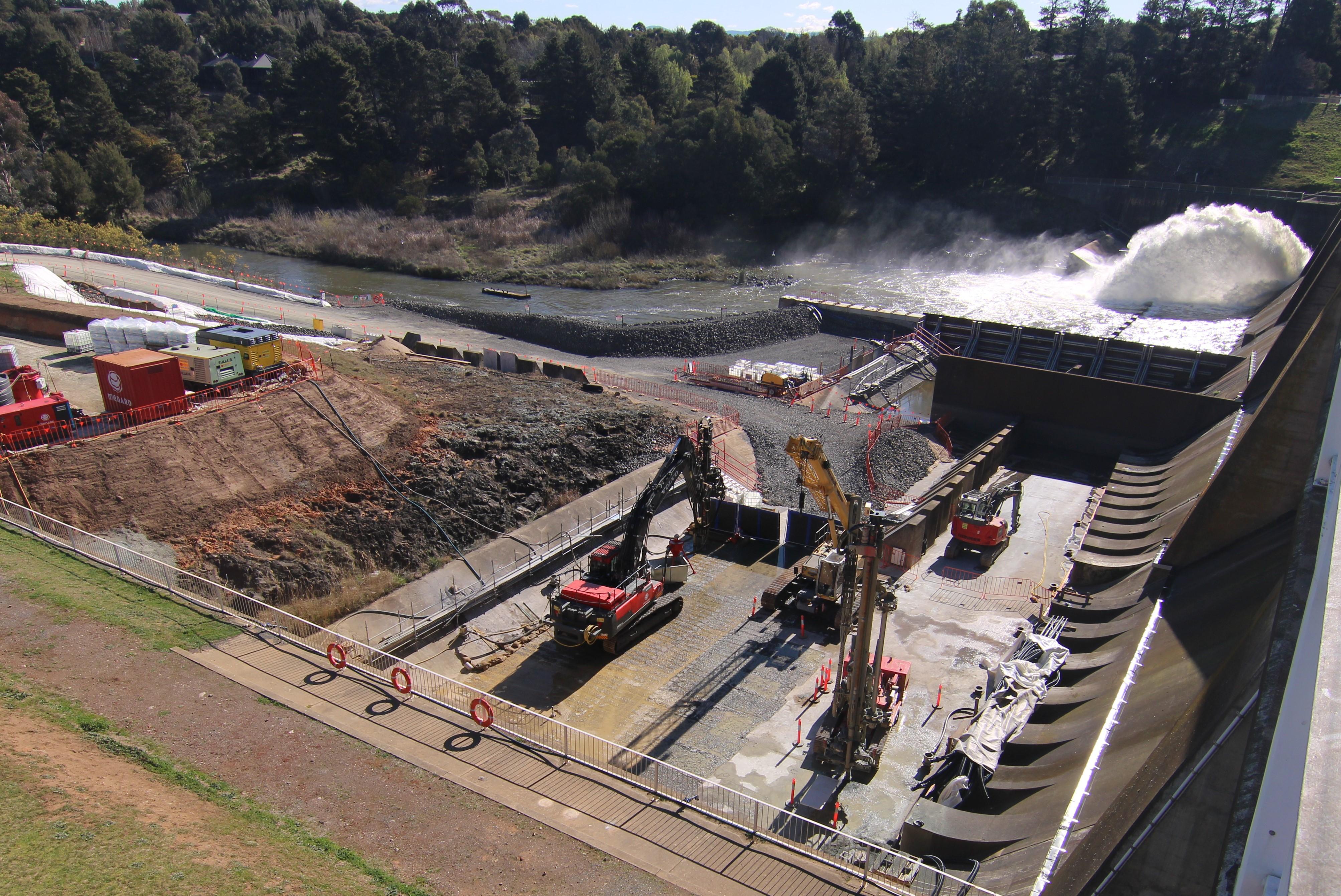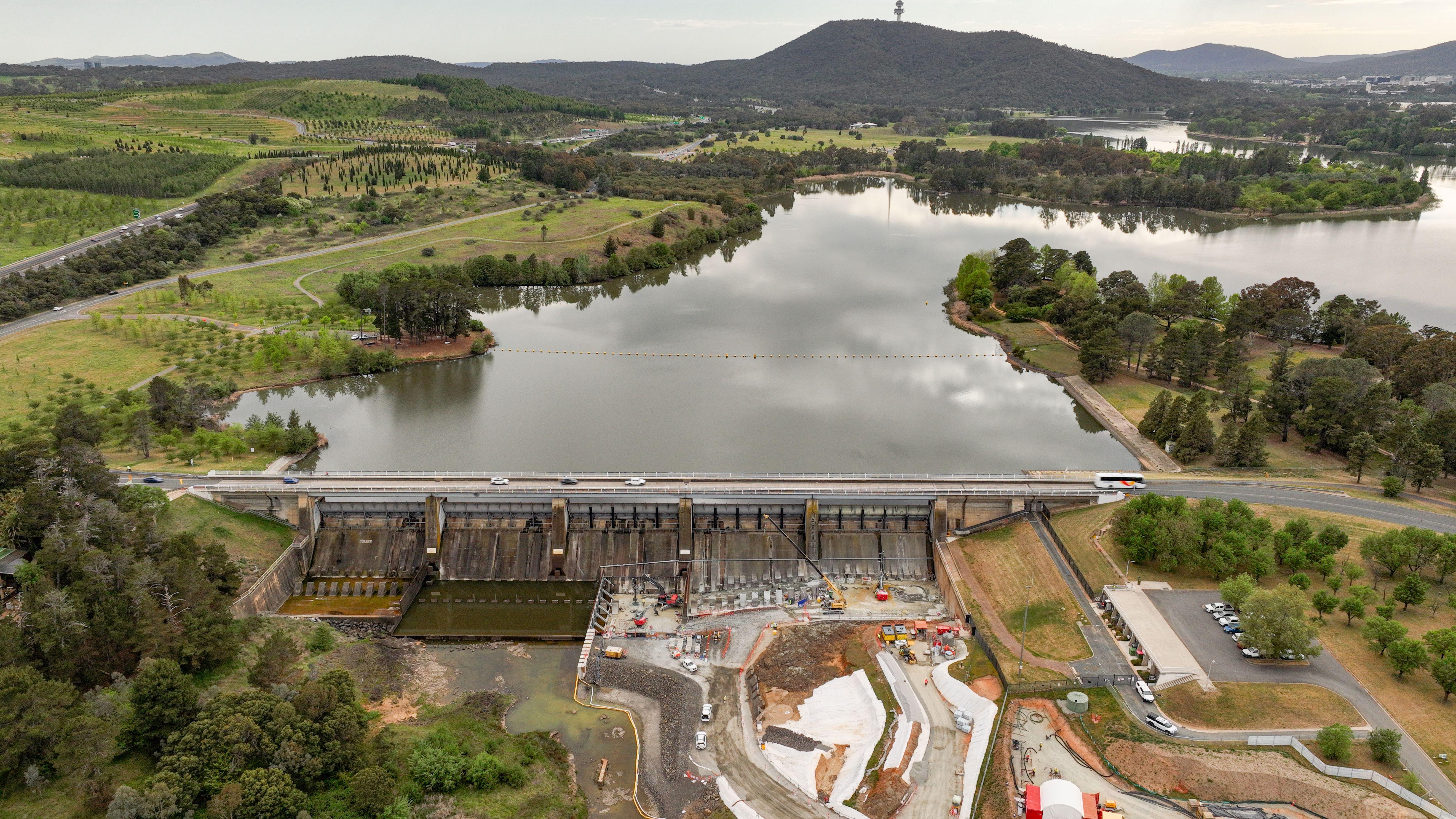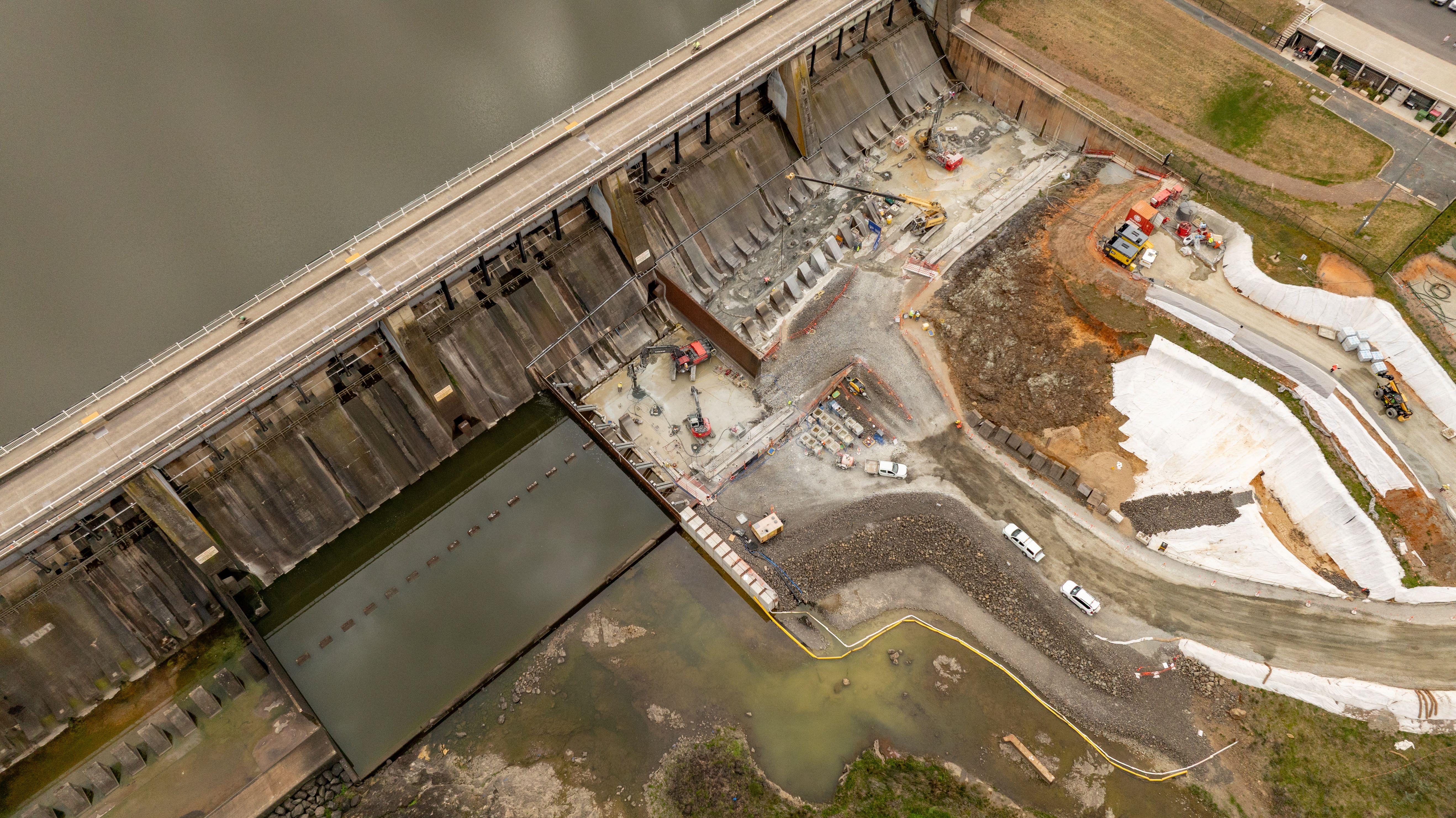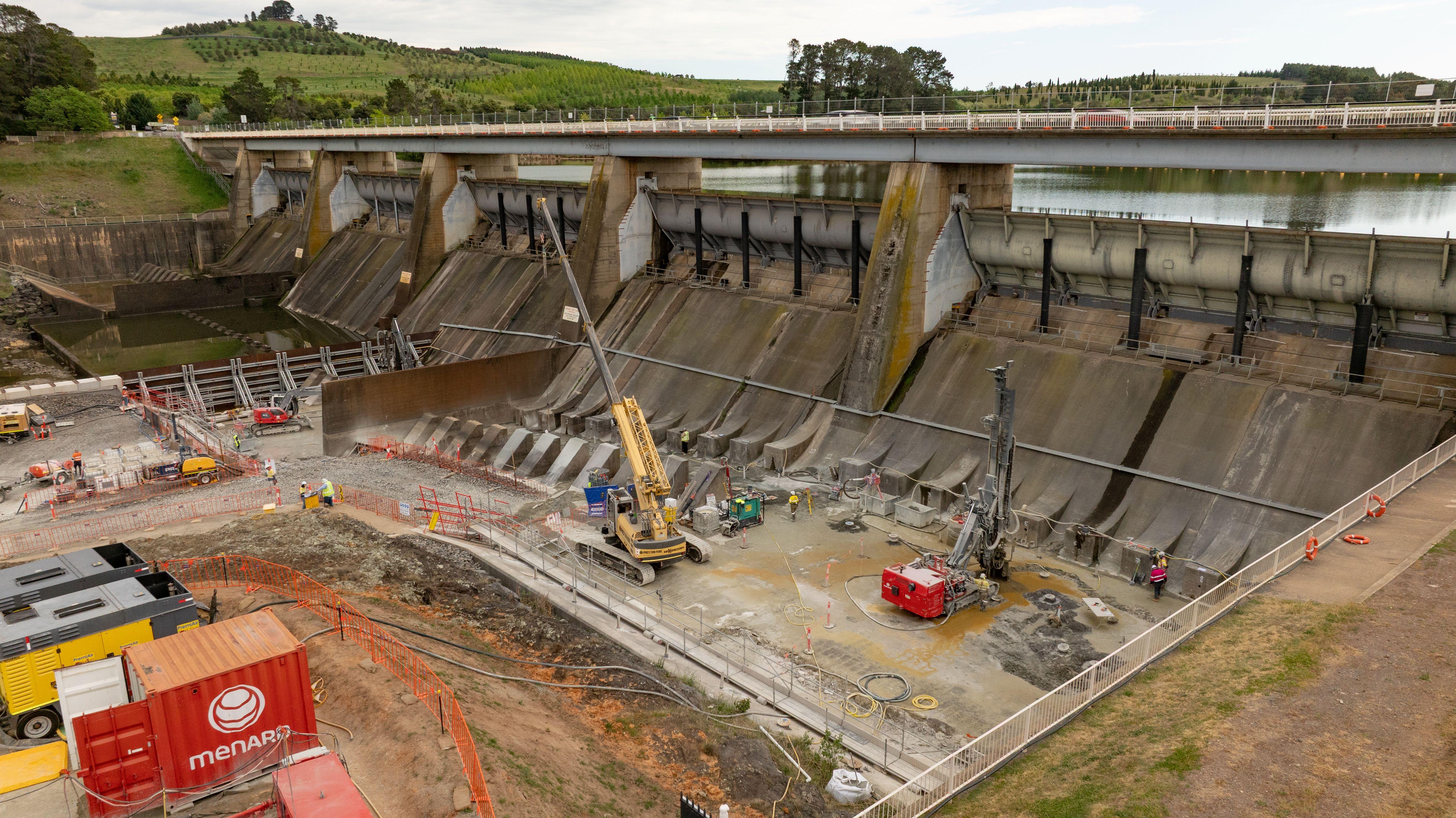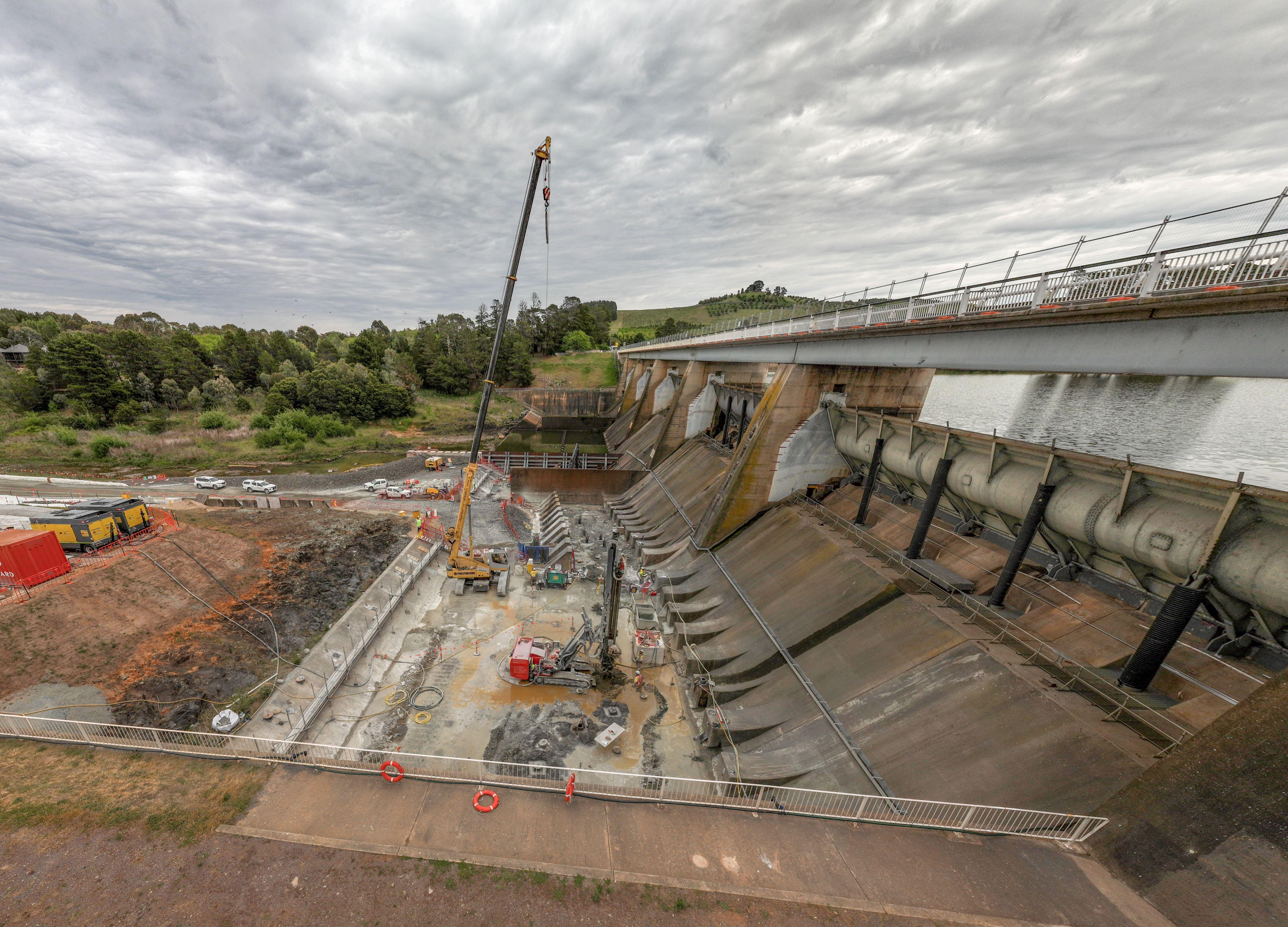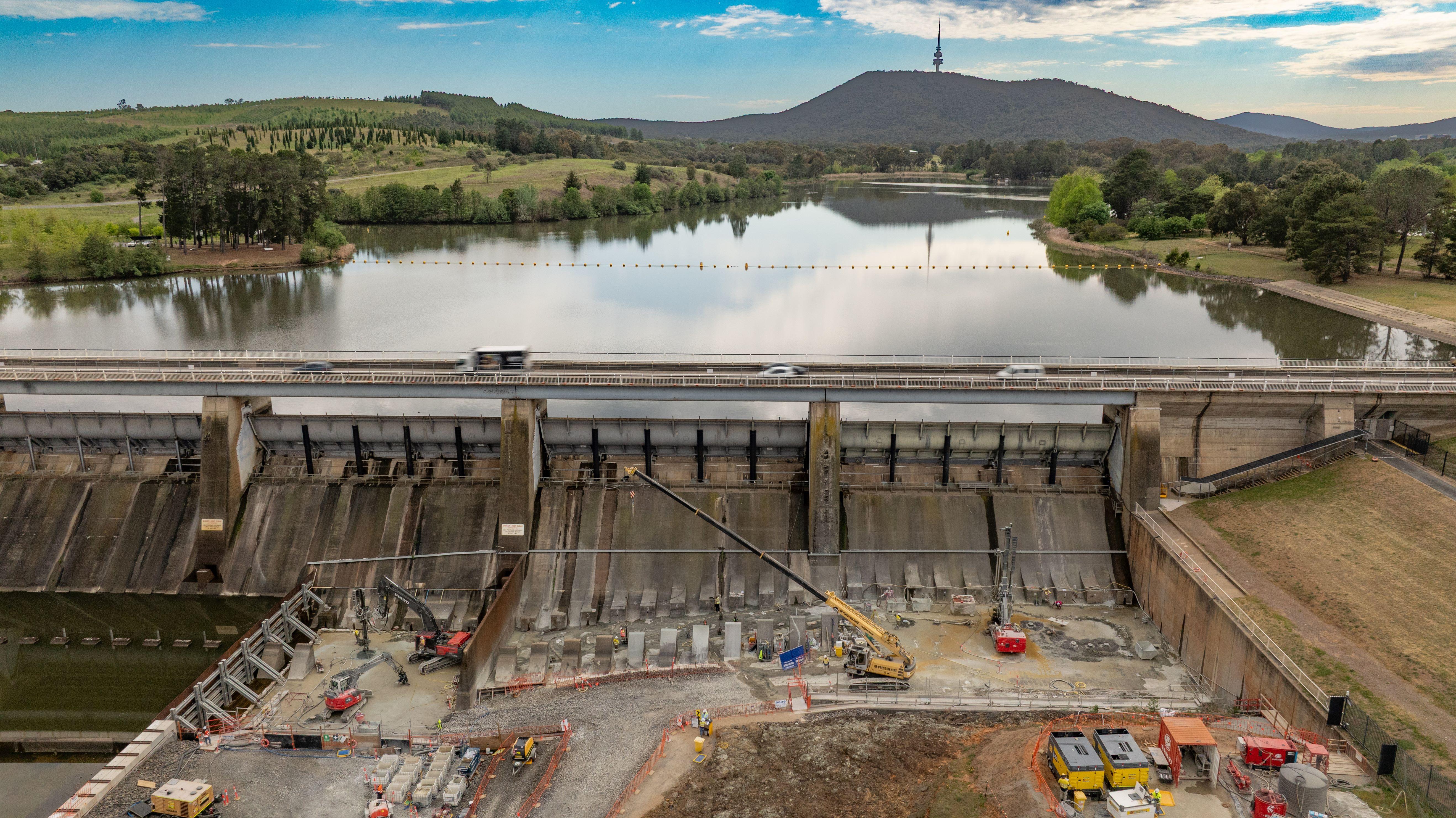Scrivener Dam Dissipator Strengthening Project
- Home
- Environment
- NCA Projects
- Current NCA projects
- Scrivener Dam Dissipator Strengthening Project
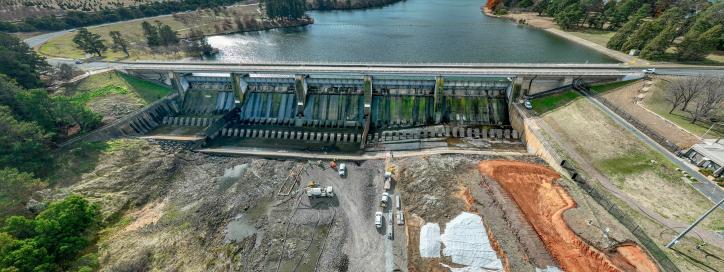
Current water level
The NCA is lowering the water level of Lake Burley Griffin to support these construction works. The latest water level reading for Lake Burley Griffin is 320mm below normal lake level (as at 19/12/25).
Current update
December 2025
The focus continues on site preparing the surface of the old concrete for the new concrete slab (using a hydro demolition robot) and drilling and installing anchors into the foundation rock beneath the dam.
Since the anchor installation process started in August this year, we've installed more than 190 anchors and in November we completed anchoring in the first of five areas.
Early next year we'll complete the first concrete pour of the new slab. This is a really precise process requiring very specific temperatures to ensure optimum outcomes. Because of the anticipated summer heat, it's likely this pour will happen as nightworks. More details will be provided closer to the time.
See the photo gallery at the bottom of the page for a look at what has been happening on site.
On this page
Project Overview
The National Capital Authority is undertaking a major project at Scrivener Dam. The project will involve strengthening work on the downstream structure of the dam – the dissipator. These works are the most significant strengthening works completed on the dam since it was first built in 1963.
About Scrivener Dam
Scrivener Dam is a concrete gravity dam responsible for retaining the water which forms Lake Burley Griffin. It plays a critical role in controlling the flow of water and managing the risk of floods by controlling water levels in Lake Burley Griffin at a consistent level through five flood gates and three sluice gates, which in turn protects the residents of Canberra from flooding and downstream areas from sudden fluctuations in water flows.
Learn more about the dam on the Scrivener Dam Attractions page.
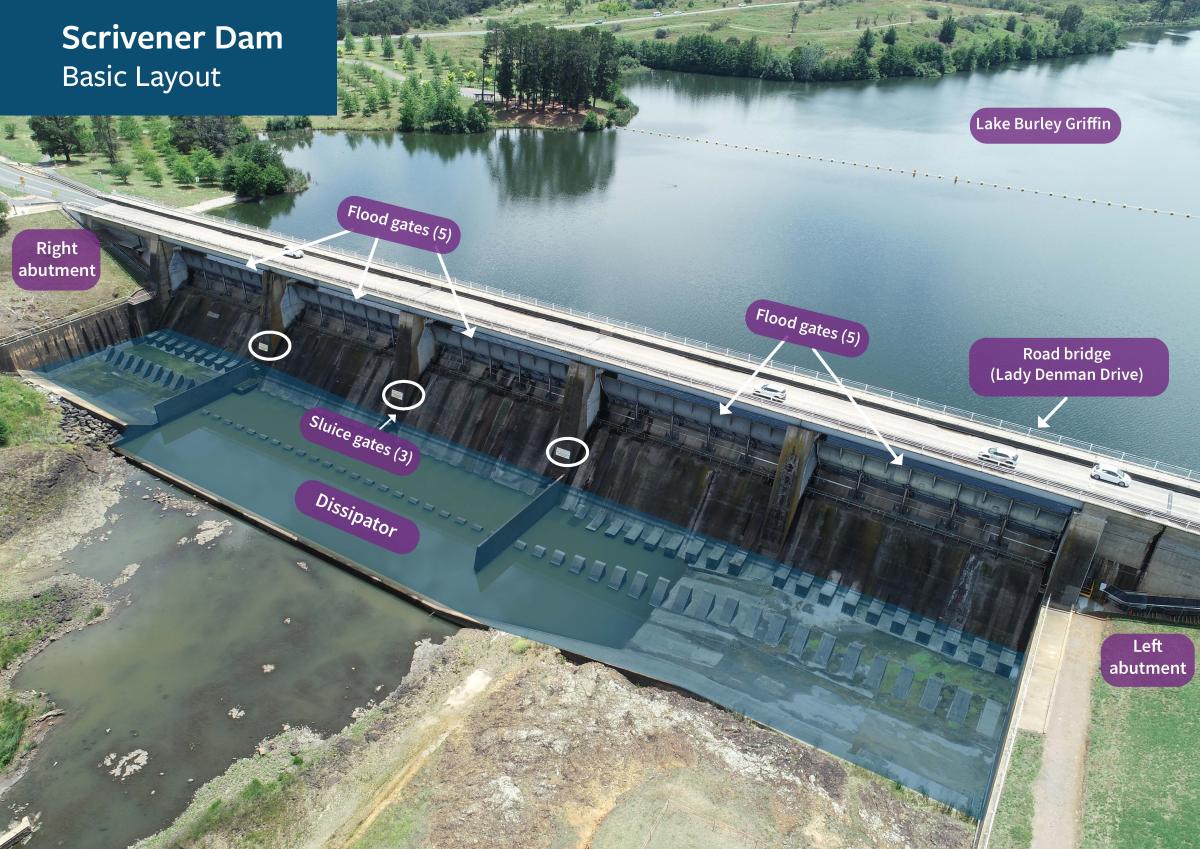
About the project
The spillway, located immediately downstream of the dam, includes a dissipator structure. The dissipator is a concrete structure comprising of a horizontal concrete slab and concrete chute blocks and vertical concrete baffle blocks. The dissipator absorbs the energy of the water flowing over the flood gates and prevents potentially damaging erosion in the river channel downstream of the dam. The chute and baffle blocks disperse water and reduce the impact of water pouring over the horizontal concrete slab structure.
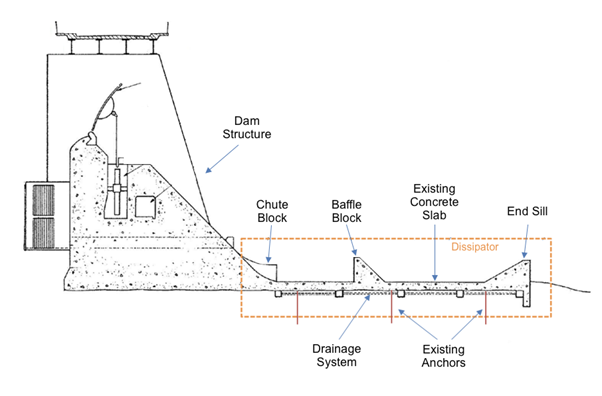
Since the dam was first constructed in 1963, standards of construction and the body of knowledge regarding dam safety have improved. Based on several investigations and studies undertaken in recent years, the NCA identified several structural risks with the dissipator of the dam.
During flood conditions, there is a risk the dissipator structure could fail, which in turn could cause the dam to fail. Hence, the dissipator strengthening project is essential to ensure the ongoing safety of the dam.
Project benefits
- Mitigate the risk of failure of the dissipator structure and, in turn, ensure ongoing safety of Scrivener Dam.
- Mitigate risk of flooding to surrounding community during flood events.
- Ensure contemporary standards are met.
- Improve safety.
Project key features
- Strengthening the existing horizontal concrete slab of the dissipater by installing approximately 700 new ground anchors into the foundation rock of the dam (10 to 20 metres deep).
- Increasing the thickness of the horizontal concrete slab of the dissipator by half a metre.
- Reconstructing new baffle blocks to match the increased thickness of the concrete slab.
- Reinforcing the adjacent riverbanks downstream of the dam to minimise erosion that could lead to failure of the dissipater structure.
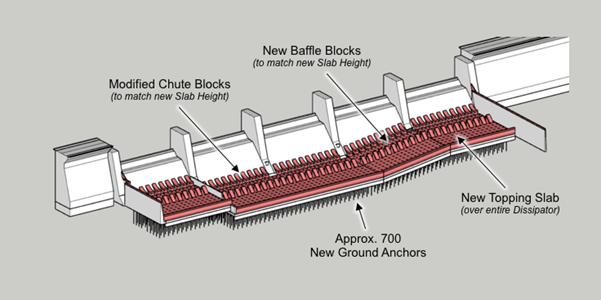
Construction
Seymour Whyte was awarded the construction contract in December 2024.
Site works began in April 2025 with major works underway from June 2025 and expected to be completed in October 2027.
During construction there will be an increase in construction traffic on Lady Denman Drive. Construction traffic will enter the site on the western access road to Scrivener Dam and will cross the existing bike path adjacent to Lady Denman Drive. Traffic will be controlled during construction hours however we urge all users to take care when navigating the area.
Lowering of Lake Burley Griffin
To manage risks associated with working in the spillway of the dam, it is necessary to lower the level of the lake during construction. It is planned to lower the lake by a maximum of 500mm during construction. This will be reduced as far as possible to minimise the impact to lake users. We urge all lake users to consider the impacts and potential new hazards prior to setting out onto the water.
Construction staging
Major works are being carried out in two main stages as shown in the image below. The stages will be separated by a temporary cofferdam which will allow operation of the dam around the construction site.
What is a cofferdam?
A temporary enclosure built within or around a body of water to create a dry area for construction or repair work.
Both stages consist of demolition of the existing baffle blocks, installation of ground anchors into the foundation rock, pouring of the new reinforced concrete slab and reconstruction of the baffle blocks on top of the new slab.
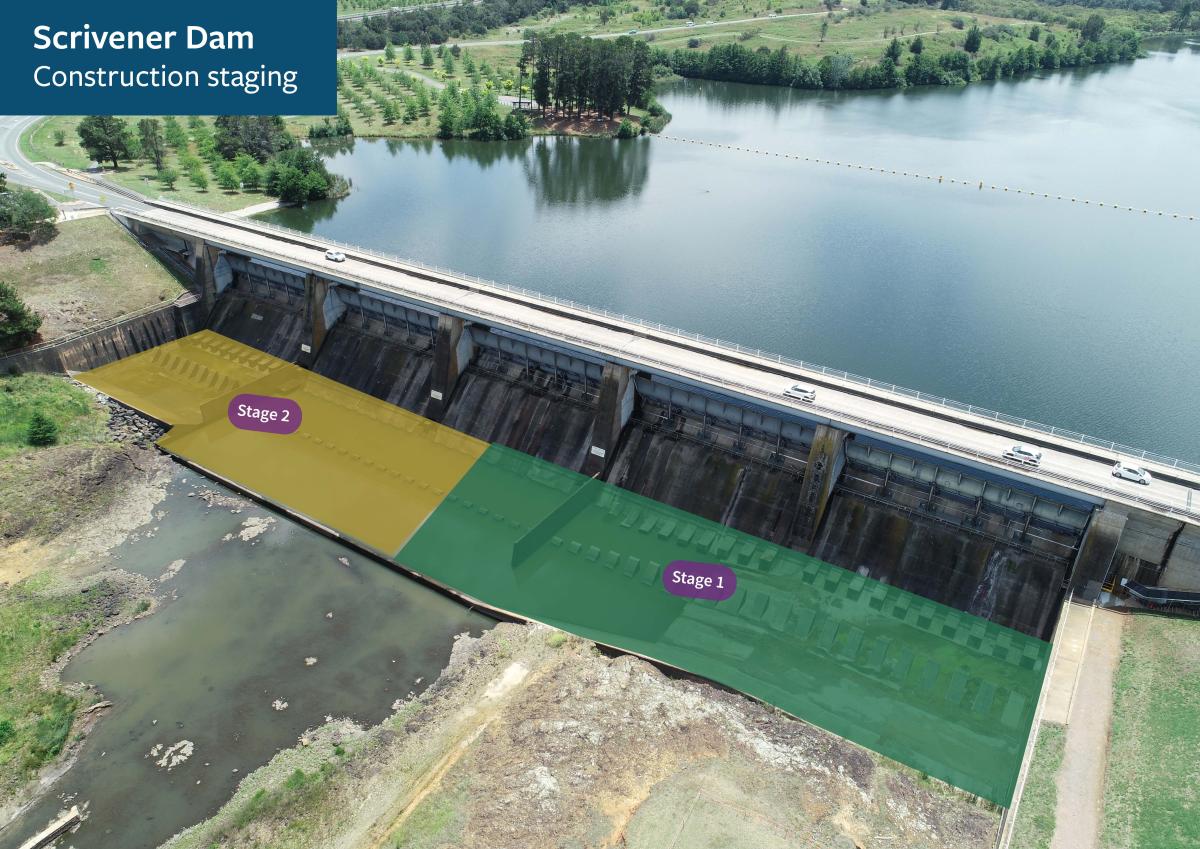
Stay up to date
Receive regular updates direct to your inbox; simply sign up using the form below
Click on the following links to view our Privacy Policy and Terms of use.
If you would like to contact the project team, email us at communications@nca.gov.au
Publications and previous announcements
2 December 2024: Project to Strengthen Scrivener Dam Moves Ahead
16 November 2023: Public Notification - Scrivener Dam Strengthening Project Call for EOIs
31 March 2022: Scrivener Dam to get needed upgrade
The construction of Scrivener Dam was completed in 1963 - which is now over 60 years ago. Since the dam was first constructed, the standards of construction and the body of knowledge regarding dam safety have improved.
Studies commissioned by the NCA identified the need to strengthen the Scrivener Dam Dissipator. NCA worked with the University of New South Wales Water Research Laboratory (UNSW WRL), and the Dam Safety Engineers (SMEC) to design, construct and test a scale model of Scrivener Dam. The model and other investigative methods were used to ascertain how the dam and its environs function under a range of operational scenarios.
The modelling and subsequent assessments identified structural risk with the dissipator under flood conditions. There is the potential for the dissipator to be significantly damaged during a major flood event, which in turn, could lead to the failure and subsequent collapse of Scrivener Dam. Hence, the NCA must undertake the Dissipator Strengthening project to ensure the ongoing safety of the dam.
Construction began on site in April 2025 with completion anticipated in October 2027 (weather permitting).
- Lowering of Lake Burley Griffin – to effectively manage the risk for construction while working in the spillway of the dam, NCA will be lowering the level of the lake. It is planned to lower the lake by a maximum of 500mm during construction. This will be reduced as far as possible to minimise the impact to lake users. The NCA urges all lake users to consider the impacts and potential new hazards prior to setting out onto the water.
- Increased traffic on Lady Denman Drive – during construction there will be an increase in construction traffic on Lady Denman Drive. Construction traffic will enter the site on the western access road to Scrivener Dam and will cross the existing bike path adjacent to Lady Denman Drive. Traffic will be controlled during construction, however NCA urges all users to take care when navigating the area. The NCA will continue to work with the community to understand and mitigate impacts wherever practical.
There will be no extended closures of the bike path or the bridge over the dam during construction. From time to time, there could be short closures to allow movement of construction vehicles, however, disruption will be kept to a minimum.
The project will involve drilling for roughly 700 new ground anchors between 10 to 20 metres deep. The process used to drill these holes will be noisy. However, the NCA undertook a noise and vibration impact assessment as part of the design for the project. The study identified all noise generated during the project will be below ACT guidelines for the areas surrounding the dam. The NCA will monitor noise during the project and will work with stakeholders to mitigate impacts during the project.
During the design phase NCA liaised with the National Zoo and Aquarium to ensure their awareness of the planned works. NCA modelled the predicted noise levels and simulated the predicted noise levels at sensitive areas of the zoo in the presence of qualified zoo staff. These tests found there would be low noise impact for sensitive areas around the zoo. Mitigations have been implemented including limiting the work hours for the project. NCA and the Head Contractor have also installed noise monitoring for the project and will continue monitoring to ensure noise levels are managed during construction.
We are keen to keep the community involved and aware of what’s happening at Scrivener Dam. Keep checking back on this website and register for project updates. If you have any questions about the project, you can email us at communications@nca.gov.au.
- Attractions
- Events
- Education
- Planning
- Planning in the National Capital
- Works Approval
- Heritage
- Heritage Strategy
- Heritage Management Plans
- ANZAC Parade Heritage Management Plan
- Acton Complex Draft Heritage Management Plan
- Australian American Memorial and Sir Thomas Blamey Square Heritage Management Plan
- Blundells Cottage Heritage Management Plan
- Changi Chapel Heritage Management Plan
- Commencement Column Monument HMP
- General Bridges Grave Heritage Management Plan
- High Court – National Gallery Precinct HMP
- King George V Memorial Heritage Management Plan
- Lake Burley Griffin and Adjacent Lands Heritage Management Plan
- National Carillon and Aspen Island Heritage Management Plan
- National Rose Gardens Heritage Management Plan
- Old Parliament House Gardens Heritage Management Plan
- Parliament House Vista Heritage Management Plan
- State Circle Cutting Heritage Management Plan
- Surveyors Hut and Surveyors Park Heritage Management Plan
- York Park Heritage Management Plan
- Heritage Management Plans under consultation
- Heritage Management Plans previous consultations
- Consultations
- Plans, policies and guidelines
- National Capital Plan
- Heritage Management Plans
- Planning Policy Review
- Urban design
- Acton Peninsula Precinct Structure Plan
- City and Gateway Urban Design Framework
- Constitution Avenue Public Realm Handbook
- Creating Places for People and Road User Hierarchy
- Deakin Forrest Residential Precinct Guidelines
- Guidelines for Commemorative Works in the National Capital
- Guidelines for Perimeter Security in the National Capital
- Outdoor Lighting Policy
- Parliamentary Zone Review
- The Griffin Legacy
- Tree Management Policy
- West Basin Precinct Guidelines
- Yarralumla Bay Recreational Hub Master Plan
- Your Capital, Your Say
- Environment
- National Land management
- Asset management
- Lake Burley Griffin
- NCA Projects
- Current NCA Projects
- Past NCA Projects
- Anzac Parade works
- Blundells Cottage Conservation and Interpretation Project
- Boundless Playground Picnic Deck
- Boundless parking extension
- Bowen Place Crossing
- Captain Cook Memorial Jet Upgrade Works
- Car Park Upgrades
- Commonwealth Park Lighting Replacement
- Dame Dorothy Tangney and Dame Enid Lyons Sculpture
- Draft Tree Management Policy
- Dunrossil Drive Pine Tree Replacement
- Furniture upgrade in Commonwealth Park
- High Mast Lighting
- International Flag Display Extension & Lighting Upgrade
- Interpretive Signage in the National Triangle
- John Gorton Building Car Park Upgrade & Associated Works
- John Gorton Building East Car Park Car Park Lighting Replacement Works
- King George V Memorial Works
- Kings Avenue Overpass
- Kings Park Improvements
- Lake Burley Griffin Wall Renewal Program
- Landscape Renewal at the Forecourt of the National Library of Australia
- Merchant Navy War Memorial Upgrade
- National Carillon Upgrade Works
- National Gallery of Australia Foreshore Upgrade
- Old Parliament House Gardens – rose name signage
- Regatta Point Redevelopment
- Restoration Works for the National Emergency Services Memorial
- Scrivener Dam Anchor Bolt Remediation
- Sir John Gorton Sculpture
- Sir John McEwen / National Party of Australia Centenary Commemoration
- Stirling Park improvements (Gura Bung Dhaura)
- Public Interest Certificates
- Parking
- About us
- Who we are
- Our Board
- Our Staff
- Volunteers
- Canberra National Memorials Committee
- History of the NCA
- 1913 - 1920 Walter Burley Griffin, Federal Capital Director of Design and Construction
- 1921 - 1924 Federal Capital Advisory Committee
- 1925 - 1930 Federal Capital Commission
- 1938 - 1957 National Capital Planning and Development Committee
- 1958 - 1989 National Capital Development Commission
- National Capital Planning Committee
- 1989 to Present Day National Capital Authority
- What we do
- Corporate documents
- Careers
- Key Governance Documents
- Video gallery
- Who we are
- Media centre
- Contact us
Acknowledgement of Country
We acknowledge the Ngunnawal people as traditional custodians of the ACT and recognise any other people or families with connection to the lands of the ACT and region.
We acknowledge and respect their continuing culture and the contribution they make to the life of this city and this region.


